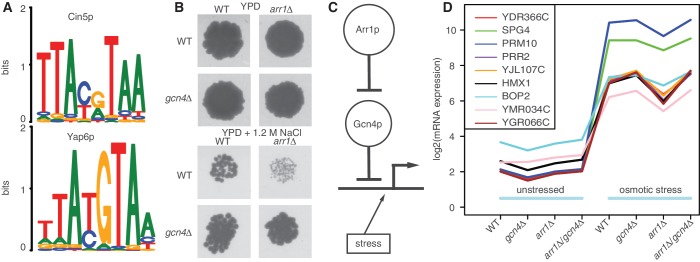Figure 4.
(A) Motifs of CIN5 and YAP6 from YeTFaSCo database. Both motifs are very similar, which is confirmed by motif search, as a test for co-occurrence of both motifs is significant (see text). (B) Growth assay on YPD plates and YPD plates containing 1.2 M NaCl after incubating for 4 days at 30°C. Only cell growth at a dilution of 1:100 is shown and the relevant parts have been extracted from the image. The full image of the experiment including replicates and negative controls can be found as Supplementary Figure S11. Growth phenotype is not affected in YPD medium. Wild-type cells have decreased phenotype under osmotic stress and arr1Δ mutants show strong decrease in growth phenotype, while gcn4Δ mutants and double mutants do not. This shows the synthetic rescue of the effect of the knockout of ARR1 in the double mutant. (C) Hypothetical model explaining the observations from the growth assay experiments (B). This model is focused on the genes that respond positively to osmotic stress (symbolized by the line with arrowhead). A double inhibition chain of Arr1p ⊣ Gcn4p leads to the observed phenotypes under osmotic stress: in wild-type cells, the inhibitory effect of Gcn4p is prevented by Arr1p and the cells grow normally. The same observation is made when knocking out GCN4 as the logic of regulation does not change. The knockout of ARR1 relieves the inhibition on Gcn4p, which in turn downregulates the target genes. We speculated that this is causing problems with osmo-adaptation, leading to a reduced cell growth. The double mutant rescues that phenotype as the genes are only driven by the osmotic stress (as in wild type). (D) Log-expression values of candidate genes responsible for synthetic rescue across all arrays. All candidates are affected by the knockout of ARR1. Four candidate genes are uncharacterized ORFs, two are proteins of unknown function and the rest has a variety of different roles in different pathways. The genes have not yet been linked to osmotic stress.

